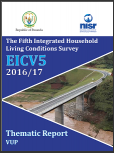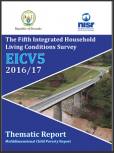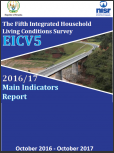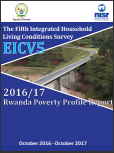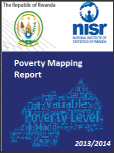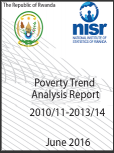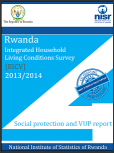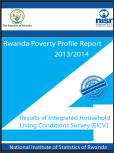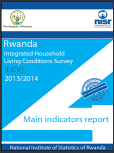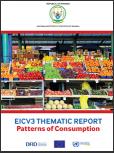EICV5-Thematic Report-VUP
The VUP program (Vision 2020 Umurenge Programme), run by the Ministry of Local Government, is the main social protection programme in Rwanda.
EICV5-Thematic Report-Multidimensional Child Poverty Report
The Multidimensional child poverty analysis, 2016/17 used data from EICV and focused on children aged 5 to 14 and 15 to 17 years. Assessing the current challenges from a child’s point of view offers important insights on the nature of poverty in Rwanda – who are the poor, why their poverty persists, and how poverty is inter-generationally transmitted.
EICV 5 - Main Indicators Report 2016/17
The Fifth Integrated Household Living Survey (EICV5) was conducted from October 2016 to October 2017, and is designed to provide accurate and up-to-date information that are useful to government, analysts and the public as they seek to monitor and evaluate efforts to reduce poverty.
EICV 5 - Rwanda Poverty Profile Report 2016/17
The Fifth Integrated Household Living Survey (EICV5) was conducted from October 2016 to October 2017, and is designed to provide accurate and up-to-date information that are useful to government, analysts and the public as they seek to monitor and evaluate efforts to reduce poverty.
The data in this report come from the fifth Integrated Living conditions survey (EICV5), which interviewed 14,580 households, representing 64,314 people, throughout the country between late October 2016 and early October 2017.
Poverty Mapping Report 2013-2014
This report complements the previous poverty analysis studies by presenting a series of poverty maps of Rwanda at cell and sector levels, based on data from EICV4 and the 2012 Population and Housing Census. A poverty map is simply a map that shows the incidence of poverty in different areas of the country. It allows the viewer to appreciate, at a glance, the geographic dimensions of poverty.
Poverty Trend Analysis Report (2010/11-2013/14)
In 2015, the National Institute of Statistics of Rwanda published the Rwanda Poverty Profile Report 2013/2014,which provided a detailed portrait of the extent and nature of poverty in the country, based on informationcollected by an integrated household living conditions survey (EICV4) undertaken between October 2013 and
September 2014.
Rwanda Social protection and VUP report - Results of EICV 4
In this report, we explore the characteristics of poor and potentially vulnerable households in Rwanda, and we analyse what types of household use the social protection programmes, especially the VUP and their experiences of doing so. Section 2 discusses the nature of vulnerability in the country. Section 3 presents the findings from the VUP.
Rwanda Poverty Profile Report - Results of EICV 4
This report provides an update on the level of poverty based on 2013/14 Integrated Household Living Conditions Survey (EICV4) focusing on poverty as measured in consumption terms. The report also highlights other trend dimensions of living conditions captured in other surveys that complement and provide a holistic understanding of poverty and living conditions.
Main indicators report - Results of EICV 4
The 2013/14 EICV is a follow-up to the 2000/01, 2005/06 and 2010/11 EICV surveys. Each survey provides information on monetary poverty measured in consumption expenditure terms, but also provides complementary socio-economic information that facilitates understanding changes in households living conditions.
The 2013/14 EICV was implemented by the National Institute of Statistics of Rwanda (NISR), in collaboration with different stakeholders in the country.
EICV 3 THEMATIC REPORT - Patterns of Consumption
The 10 thematic reports in this series are: (i) Economic Activity; (ii) Utilities and Amenities (water/sanitation/energy/housing/transport/ICT); (iii) Social Protection; (iv) Environment and Natural Resources; (v) Consumption; (vi) Gender; (vii) Youth; (viii) Education; (ix) Agriculture and (x) Income.

